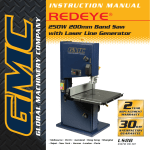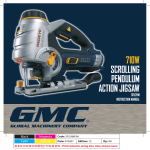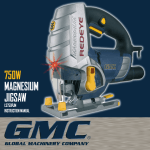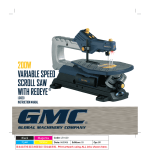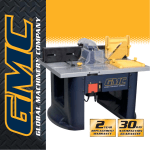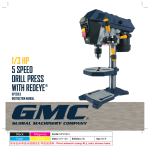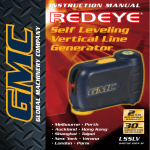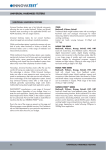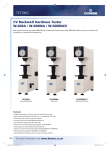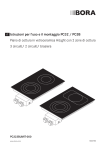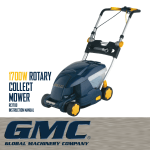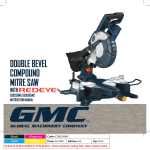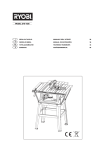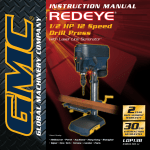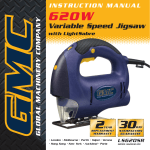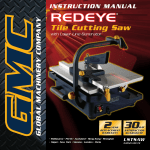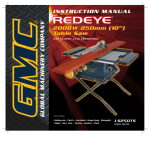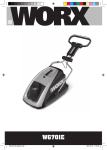Download Global Machinery Company LS236LS User's Manual
Transcript
INSTRUCTION MANUAL 2300W 235mm (9-1/4”) Circular Saw with Laser Line Generator* • Melbourne • Perth • Auckland • Hong Kong • Shanghai • Taipei • New York • Verona • London • Paris LS236LS 040421 ED12 PR Contents Warranty Introduction Environmental protection Description of symbols Specifications General safety rules Additional safety rules for laser lights Additional safety rules for circular saws Know your product Accessories Unpacking Assembly Overview Adjusting the cutting depth Adjusting the bevel angle Adjusting the bevel setting Adjusting the angle pointer Switching on and off Making a cut Using the parallel fence guide Dust extraction Using the REDEYE® system Changing the blade Maintenance General inspection Repairs 2 3 3 3 3 4 5 6 8 9 9 9 9 9 10 10 11 11 11 12 12 12 13 14 14 14 Full 2 Years Commercial and Trade Use Warranty Whilst every effort is made to ensure your complete satisfaction with this tool, occasionally, due to the mass manufacturing techniques, a tool may not live up to our required level of performance and you may need the assistance of our service department. This product is warranted for a 2-year period for commercial and trade use from the date of the original purchase. If found to be defective in materials or workmanship, the tool or the offending faulty component will be replaced free of charge with another of the same item. A small freight charge may apply. The warranty replacement unit is only made available by returning the tool to the place of purchase with a confirmed register receipt. Proof of purchase is essential. We reserve the right to reject any claim where the purchase cannot be verified. This warranty does not include damage or defects to the tool caused by or resulting from abuse, accidents or alterations. It also does not cover any bonus accessories unless the tool is a GMC Platinum Professional model. Please ensure that you store your receipt in a safe place. Conditions apply to the above warranty. If you need direction of what constitutes a free of charge warranty claim, please review the guide given on the rear of the Receipt Holder. An indication is given as to the types of claim that are permissible, and those that are not. Description of symbols Dear Customer The rating plate on your tool may show symbols. These represent important information about the product or instructions on its use. Wear hearing protection. Wear eye protection. Wear breathing protection. If you require any help with your product, whether it is a Warranty claim, spare part or user information, please phone our Help Line for an immediate response. Phone 1300 880 001 in Australia or 0800 445 721 in New Zealand. Introduction Double insulated for additional protection. Your new GMC power tool will more than satisfy your expectations. It has been manufactured under stringent GMC Quality Standards to meet superior performance criteria. You will find your new tool easy and safe to operate, and, with proper care, it will give you many years of dependable service. Caution. Carefully read through this entire Instruction Manual before using your new GMC Power Tool. Take special care to heed the Cautions and Warnings. Your GMC power tool has many features that will make your job faster and easier. Safety, performance, and dependability have been given top priority in the development of this tool, making it easy to maintain and operate. Conforms to relevant standards for electromagnetic compatibility. Specifications Voltage: 230–240V ~ 50 Hz Input power: 2300W No load speed: 4500min -1 Blade diameter: Ø235mm Blade teeth: 20 TCT Blade kerf: 2.5mm Blade arbour: 25mm Bevel capacity: 0 to 45° Depth of cut at 90°: 87mm Depth of cut at 45°: 56mm Insulation: Double insulated WARNINGS. 1. Never use a blade thinner than 1.2mm or thicker than 2.5mm 2. Do not use High Speed Steel (HSS) blades. Environmental protection Recycle unwanted materials instead of disposing of them as waste. All tools, hoses and packaging should be sorted, taken to the local recycling centre and disposed of in an environmentally safe way. WARNING. 1. It may be more difficult to see the laser line in conditions of bright sunshine and on certain surfaces. 3 General safety rules Personal safety • Stay alert, watch what you are doing and use common sense when operating a power tool. Do not use a power tool while you are tired or under the influence of drugs, alcohol, or medication. A moment of inattention while operating power tools may result in serious personal injury. • Use safety equipment. Always wear eye protection. Safety equipment such as a dust mask, non-skid safety shoes, hard hat, or hearing protection used for appropriate conditions will reduce personal injuries. • Avoid accidental starting. Ensure the switch is in the off-position before plugging in. Carrying power tools with your finger on the switch or plugging in power tools that have the switch on invites accidents. • Remove any adjusting key or wrench before turning the tool on. A wrench or a key that is left attached to a rotating part of the power tool may result in personal injury. • Do not overreach. Keep proper footing and balance at all times. This enables better control of the power tool in unexpected situations. • Dress properly. Do not wear loose clothing or jewellery. Keep your hair, clothing and gloves away from moving parts. Loose clothes, jewellery or long hair can be caught in moving parts. • If devices are provided for the connection of dust extraction and collection facilities ensure that these are connected and properly used. Use of these devices can reduce dust-related hazards. Power tool use and care • Do not force the power tool. Use the correct power tool for your application. The correct power tool will do the job better and safer at the rate for which it was designed. • Do not use the power tool if the switch does not turn it on and off. Any power tool that cannot be controlled with the switch is dangerous and must be repaired. WARNING! Read and understand all instructions. Failure to follow all instructions listed below may result in electric shock, fire and/or serious injury. The term “power tool” in all of the warnings below refers to your mains-operated (corded) power tool or battery-operated (cordless) power tool. Save these instructions Work area • Keep work area clean and well lit. Cluttered and dark areas invite accidents. • Do not operate power tools in explosive atmospheres, such as in the presence of flammable liquids, gases, or dust. Power tools create sparks which may ignite the dust or fumes. • Keep children and bystanders away while operating a power tool. Distractions can cause you to lose control. Electrical safety • Power tool plugs must match the outlet. Never modify the plug in any way. Do not use any adapter plugs with earthed (grounded) power tools. Unmodified plugs and matching outlets will reduce risk of electric shock. • Avoid body contact with earthed or grounded surfaces such as pipes, radiators, ranges and refrigerators. There is an increased risk of electric shock if your body is earthed or grounded. • Do not expose power tools to rain or wet conditions. Water entering a power tool will increase the risk of electric shock. • Do not abuse the cord. Never use the cord for carrying, pulling or unplugging the power tool. Keep cord away from heat, oil, sharp edges or moving parts. Damaged or entangled cords increase the risk of electric shock. • When operating a power tool outdoors, use an outdoor extension cord suitable for outdoor use. Use of a cord suitable for outdoor use reduces the risk of electric shock. 4 Additional safety rules for laser lights • Disconnect the plug from the power source before making any adjustments, changing accessories, or storing power tools. Such preventive safety measures reduce the risk of starting the power tool accidentally. • Store idle power tools out of the reach of children and do not allow persons unfamiliar with the power tool or these instructions to operate the power tool. Power tools are dangerous in the hands of untrained users. • Maintain power tools. Check for misalignment or binding of moving parts, breakage of parts and any other condition that may affect the power tool’s operation. If damaged, have the power tool repaired before use. Many accidents are caused by poorly maintained power tools. • Keep cutting tools sharp and clean. Properly maintained cutting tools with sharp cutting edges are less likely to bind and are easier to control. • Use the power tool, accessories and tool bits etc., in accordance with these instructions and in the manner intended for the particular type of power tool, taking into account the working conditions and the work to be performed. Use of the power tool for operations different from intended could result in a hazardous situation. Service • Have your power tool serviced by a qualified repair personnel using only identical replacement parts. This will ensure that the safety of the power tool is maintained. The laser light/laser radiation used in the GMC REDEYE® system is Class 2 with maximum 1mW and 400nm – 700nm wavelengths. These lasers do not normally present an optical hazard, although staring at the beam may cause flash blindness. WARNING. Do not stare directly at the laser beam. A hazard may exist if you deliberately stare into the beam. Please observe all safety rules as follows: • The laser shall be used and maintained in accordance with the manufacturer’s instructions. • Never aim the beam at any person or an object other than the work piece. • The laser beam shall not be deliberately aimed at personnel and shall be prevented from being directed towards the eye of a person for longer than 0.25s. • Always ensure the laser beam is aimed at a sturdy work piece without reflective surfaces, i.e. wood or rough coated surfaces are acceptable. Bright shiny reflective sheet steel or the like is not suitable for laser use as the reflective surface could direct the beam back at the operator. • Do not change the laser light assembly with a different type. Repairs must only be carried out by the laser manufacturer or an authorised agent. LASER LIGHT. LASER RADIATION Do not stare into beam. Only turn laser beam on when tool is on work piece. Class 2 laser product CAUTION. Use of controls or adjustments or performance of procedures other than those specified herein may result in hazardous radiation exposure. Please refer to the relevant Australian standards, AS 2397 and AS/NZS2211 for more information on Lasers. 5 Additional safety rules for circular saws • When the blade is pinched or bound tightly by the kerf closing down, the blade stalls and the motor reaction drives the unit rapidly back toward the operator; • If the blade becomes twisted or misaligned in the cut, the teeth at the back edge of the blade can dig into the top surface of the wood causing the blade to climb out of the kerf and jump back toward the operator. Kickback is the result of saw misuse and/or incorrect operating procedures or conditions and can be avoided by taking proper precautions as given below. a) Maintain a firm grip with both hands on the saw and position your arms to resist kickback forces. Position your body to either side of the blade, but not in line with the blade. Kickback could cause the saw to jump backwards, but kickback forces can be controlled by the operator, if proper precautions are taken. b) When blade is binding, or when interrupting a cut for any reason, release the trigger and hold the saw motionless in the material until the blade comes to a complete stop. Never attempt to remove the saw from the work or pull the saw backward while the blade is in motion or kickback may occur. Investigate and take corrective actions to eliminate the cause of blade binding. c) When restarting a saw in the workpiece, centre the saw blade in the kerf and check that saw teeth are not engaged into the material. If saw blade is binding, it may walk up or kickback from the workpiece as the saw is restarted. d) Support large panels to minimise the risk of blade pinching and kickback. Large panels tend to sag under their own weight. Supports must be placed under the panel on both sides, near the line of cut and near the edge of the panel. DANGER a) Keep hands away from cutting area and the blade. Keep your second hand on auxiliary handle, or motor housing. If both hands are holding the saw, they cannot be cut by the blade. b) Do not reach underneath the workpiece. The guard cannot protect you from the blade below the workpiece. c) Adjust the cutting depth to the thickness of the workpiece. Less than a full tooth of the blade teeth should be visible below the workpiece. d) Never hold piece being cut in your hands or across your leg. Secure the workpiece to a stable platform. It is important to support the work properly to minimize body exposure, blade binding, or loss of control. e) Hold power tool by insulated gripping surfaces when performing an operation where the cutting tool may contact hidden wiring or its own cord. Contact with a “live” wire will also make exposed metal parts of the power tool “live” and shock the operator. f) When ripping always use a rip fence or straight edge guide. This improves the accuracy of cut and reduces the chance of blade binding. g) Always use blades with correct size and shape (diamond versus round) of arbour holes. Blades that do not match the mounting hardware of the saw will run eccentrically, causing loss of control. h) Never use damaged or incorrect blade washers or bolt. The blade washers and bolt were specially designed for your saw, for optimum performance and safety of operation. Causes and operator prevention of kickback: • Kickback is a sudden reaction to a pinched, bound or misaligned saw blade, causing an uncontrolled saw to lift up and out of the workpiece toward the operator; 6 e) Do not use dull or damaged blades. Unsharpened or improperly set blades produce narrow kerf causing excessive friction, blade binding and kickback. f) Blade depth and bevel adjusting locking levers must be tight and secure before making cut. If blade adjustment shifts while cutting, it may cause binding and kickback. g) Use extra caution when making a “plunge cut” into existing walls or other blind areas. The protruding blade may cut objects that can cause kickback. a) Check lower guard for proper closing before each use. Do not operate the saw if lower guard does not move freely and close instantly. Never clamp or tie the lower guard into the open position. If saw is accidentally dropped, lower guard may be bent. Raise the lower guard with the retracting handle and make sure it moves freely and does not touch the blade or any other part, in all angles and depths of cut. b) Check the operation of the lower guard spring. If the guard and the spring are not operating properly, they must be serviced before use. Lower guard may operate sluggishly due to damaged parts, gummy deposits, or a build-up of debris. c) Lower guard should be retracted manually only for special cuts such as “plunge cuts” and “compound cuts.” Raise lower guard by retracting handle and as soon as blade enters the material, the lower guard must be released. For all other sawing, the lower guard should operate automatically. d) Always observe that the lower guard is covering the blade before placing saw down on bench or floor. An unprotected, coasting blade will cause the saw to walk backwards, cutting whatever is in its path. Be aware of the time it takes for the blade to stop after switch is released. 7 Know your product 1. Laser light assembly 2. Laser aperture 3. Trigger switch 4. Laser light on/off button 5. Motor housing 6. Main handle 7. Front handle 8. Bevel adjustment lever 9. Bevel scale 10. Parallel fence locking knob 11. Parallel fence 12. Blade guard lever 13. Lower blade guard 14. Base plate 15. Upper blade guard 16. Dust extraction port 17. Dust extraction adaptor 18. Depth locking lever 19. Depth of cut indicator 20. Spindle lock button 21. Blade 22. Blade wrench 23. Blade guide notch 4 1 2 7 12 16 9 15 8 14 21 13 23 11 20 3 6 10 17 19 11 5 18 22 14 8 Accessories The GMC LS236LS Circular Saw is supplied with the following accessories as standard: 1. Blade wrench 2. Blade (fitted) 3. Parallel fence guide 4. Dust extraction adaptor 5. Instruction manual 6. Receipt holder By loosening the bevel adjustment lever (8), the body and the blade of the saw can be tilted to any angle up to 45° for making angle cuts. Please note that the maximum depth of cut is reduced when cutting at an angle. A fixed guard (15) encloses the upper part of the blade. As the saw advances through the work piece, the pivoting lower blade guard (13) is pushed back by the edge of the wood to expose only that part of the blade which is needed. When the blade clears the work, the spring loaded lower blade guard snaps back to completely enclose the blade. Unpacking Adjusting the cutting depth Due to modern mass production techniques, it is unlikely that your GMC Power Tool is faulty or that a part is missing. If you find anything wrong, do not operate the tool until the parts have been replaced or the fault has been rectified. Failure to do so could result in serious personal injury. CAUTION. Always ensure that the saw is switched off and unplugged from the power supply before making any adjustments. 1. Ensure that the saw is facing away from you. 2. Loosen the depth locking lever (18). 3. Hold the base plate flat against the edge of the work piece and lift the body of the saw until the blade is at the right depth. Use the depth of cut indicator (19) to determine the cutting depth. 4. Tighten the depth locking lever (18). Assembly The saw is packed, fully assembled. Overview You have purchased a 2300 watt heavy duty circular saw with the REDEYE® laser line generator. Please refer to the safety instructions given earlier in this manual for important instructions regarding the use of the laser. The saw is capable of ripping and cross cutting hardwoods, softwoods and man made boards quickly, accurately and safely. If the tool becomes too hot, let it run under no load for 2–3 minutes to cool the motor. The quality of the cut will improve as the number of blade teeth increases. The blade cuts on an upward stroke and may chip the uppermost surface or edges of your work piece. When cutting, ensure that your uppermost surface is a non-visible surface when your work is finished. 9 Note. Always use the correct blade depth setting. The correct blade depth setting for all cuts should not be more than 6mm below the material being cut. Allowing more depth will increase the chance of kickback and result in a rough cut. Note. Always make a trial cut in a scrap piece of material along a guideline to determine how much you should offset the blade from the guideline to make an accurate cut. Adjusting the bevel setting Adjusting the bevel angle CAUTION. Always ensure that the saw is switched off and unplugged from the power supply before making any adjustments. 1. The saw can be adjusted to cut at any angle between 0° and 45°. When making 45° bevel cuts, there is a notch (23) in the saw base to help you line up the blade with the line of cut. Align your line of cut with the inner blade guide notch on the base of the saw when making 45° bevel cuts. 2. Loosen the bevel adjustment lever (8) located at the front of the base plate. 3. Tilt the body of the saw until the required angle is reached using the bevel scale (9) as a guide. 4. Tighten the bevel adjustment lever (8) to secure the base plate. CAUTION. Always ensure that the saw is switched off and unplugged from the power supply before making any adjustments. 1. Ensure power is disconnected from the mains socket. 2. With the saw turned upside down and the lower guard fully retracted, check that the saw blade is at 90° to the base. 3. If adjustment is necessary, adjust as follows. 4. Loosen the lock nut of the stop screw found beside the parallel fence locking knob (10) and turn it either in or out to adjust the base down onto the screw. 4. Re-check the blade until it is at 90° to the base. 5. Lock the screw with the lock nut. 10 Adjusting the angle pointer Making a cut When the angles are corrected on the saw, it is wise to adjust the pointer. 1. Set the angle as desired and loosen the screw securing the pointer. 2. Move the pointer to the corresponding angle and tighten the screw. 1. Mark the line of cut on the work piece. 2. Adjust the depth of cut and bevel angle as required. 3. When making 90° cross or rip cuts, align your line of cut with the outer blade guide notch on the base of the saw. 4. When making 45° bevel cuts, align your line of cut with the inner blade guide notch on the base of the saw. 5. Rest the front edge of the base on the workpiece. 6. Start the motor by squeezing the trigger switch (3). 7. Always let the blade reach full speed (approximately 2 seconds) before you begin to cut into the workpiece. 8. Slowly push the saw forward using both hands. 9. When making a cut always use steady, even pressure. Forcing the saw causes rough cuts and could shorten the life of the saw or cause kickback. Allow the blade and the saw to do the work. 10. After completing your cut, release the trigger switch and allow the blade to come to a complete stop. Do not remove the saw from the work piece while the blade is moving. Switching on and off 1. Connect the plug to the power supply. 2. To switch on the saw, squeeze the trigger switch (3). 3. When you release the trigger, the saw turns off. CAUTION. Allow the blade to come to a complete standstill before setting the saw down. 11 Dust extraction Note. Since blade thickness varies, always make a trial cut in scrap material along the guideline to determine how much, if any, the guideline must be offset to get an accurate cut. The tool can be connected to a dust extraction system via the dust extraction adaptor (17). 1. Fit the dust extraction adaptor (17) over the dust extraction port (16). 2. Using the two phillips head screws supplied secure the dust extraction port onto the saw. 3. Connect your dust extraction equipment onto the dust extraction adaptor. Using the parallel fence guide The parallel fence allows you to make parallel cuts in a sheet of wood, all at the same width. CAUTION. Always ensure that the saw is switched off and unplugged from the power supply before making any adjustments. 1. Loosen the parallel fence locking knob (10) 2. Slide the parallel fence (11) through the slots in the base plate (14). 3. Adjust the parallel fence to the required width and secure it in position with the parallel fence locking knob (10). 4. Ensure that the fence rests against the wood along its entire length to give a consistent parallel cut. Using the REDEYE® system WARNINGS. Do not stare directly at the laser beam. Never aim the beam at any person or an object other than the work piece. Do not deliberately aim the beam at personnel and ensure that it is not directed towards the eye of a person for longer than 0.25s. Always ensure the laser beam is aimed at a sturdy work piece without reflective surfaces. I.e. wood or rough coated surfaces are acceptable. Bright shiny reflective sheet steel or the like is not suitable for laser use as the reflective surface could direct the beam back at the operator. Only turn laser beam on when tool is on work piece. 1. Mark the line of the cut on the work piece. 2. Adjust the depth of cut and bevel angle as required. 3. Rest the front edge of the base on the work piece. 4. Switch on the laser beam by pressing the laser light on/off button (4). 5. Start the motor by squeezing the trigger switch (3). 12 6. Align the beam with the line on the work piece. 7. Always let the blade reach full speed (approximately 2 seconds) before you begin to cut into the work piece. 8. Slowly push the saw forward using both hands, keeping the red laser light beam on the line of cut. 9. After completing your cut, release the trigger switch and allow the blade to come to a complete stop. Do not remove the saw from the work piece while the blade is moving. Changing the blade CAUTION. Always ensure that the saw is switched off and unplugged from the power supply before making any adjustments. 1. Place saw on its side on a flat surface. 2. Rotate the saw blade by hand whilst depressing the spindle lock button (20) until the blade locks. 3. Whilst depressing the spindle lock button, turn the blade bolt anti-clockwise using the wrench provided. 4. Remove the outer blade flange and the blade bolt. 5. Raise the lower blade guard (13) using the blade guard lever (12). 6. Remove the saw blade from the inner flange and pull it out. 7. Clean the saw blade flanges thoroughly before mounting the new saw blade. Wipe a drop of oil onto the inner and outer flange where they will touch the blade. 8. Mount the new saw blade onto the spindle and against the inner flange. 9. Replace the outer flange and tighten the blade bolt. WARNING. The direction in which the blade rotates has to be the same as the direction of the arrow marked on the housing. 10. Ensure that the spindle lock button (20) is released. 11. Before using the saw again, check that the safety devices are in good working order. Important. After replacing the saw blade, make sure that the saw blade runs freely by turning the blade by hand. 12. Plug the machine into a power socket and run the saw under no load to check that it runs smoothly before using it to cut any material. 13 Maintenance 1. Keep the tool’s air vents unclogged and clean at all times. 2. Remove dust and dirt regularly. Cleaning is best done with a soft rag or a soft brush. Wear safety glasses to protect your eyes while cleaning. 3. Re-lubricate all moving parts at regular intervals. 4. If the body of the saw needs cleaning, wipe it with a soft damp cloth. A mild detergent can be used but nothing like alcohol, petrol or other cleaning agent. 5. Never use caustic agents to clean plastic parts. CAUTION. Water must never come into contact with the saw. General inspection Regularly check that all the fixing screws are tight. They may vibrate loose over time. Repairs Only an authorised service centre should replace the cordset or effect other repairs. If the supply cord needs replacing, the task must be carried out by the manufacturer, the manufacturer’s agent, or an authorised service centre in order to avoid a safety hazard. 14 Carefully read the entire Instruction Manual before using this product. Before returning this product for a Warranty Claim or any other reason Please Call 1300 880 001 (Australia) or 0800 445 721 (New Zealand) When you make your call, please have the following information at hand: With continuing product development changes may have occurred which render the product received slightly different to that shown in this instruction manual. The manufacturer reserves the right to change specifications without notice. Note: Specifications may differ from country to country. • GMC Product Type • GMC Product Code A GMC Service Engineer will take your call and, in most cases, will be able to solve your problem over the phone. You are welcome to use this phone-in service to make suggestions or give comments about any GMC product. 45–55 South Centre Road Melbourne Airport Victoria, Australia 3045 Tel: (03) 8346 1100 Fax: (03) 8346 1200 The GMC 777 Helpline operates from 7am to 7pm, 7 days a week (EST). This allows you to contact GMC directly with any queries and technical questions you have regarding our products. Save this Manual for future reference.















